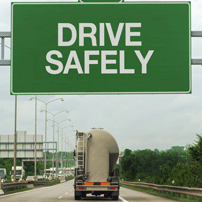Steer Clear of Truck’s “No Zones”
April 4, 2018 Driving next to a large commercial truck can feel a bit intimidating due to its massive size and weight. Because they are so large, big rigs have substantial blind spots, which are also referred to as “no zones.” When other vehicles in the vicinity are driving within those “no zones,” the truck driver is unable to see that vehicle. This can result in devastating truck accidents if the truck driver changes lanes when another vehicle is in the truck’s blind spot. The passenger vehicle can be crushed, forced off the road, or end up hitting another vehicle because the truck driver did not see the other motorist.
Driving next to a large commercial truck can feel a bit intimidating due to its massive size and weight. Because they are so large, big rigs have substantial blind spots, which are also referred to as “no zones.” When other vehicles in the vicinity are driving within those “no zones,” the truck driver is unable to see that vehicle. This can result in devastating truck accidents if the truck driver changes lanes when another vehicle is in the truck’s blind spot. The passenger vehicle can be crushed, forced off the road, or end up hitting another vehicle because the truck driver did not see the other motorist.
Unfortunately, the occupants of the passenger vehicle tend to suffer the most severe injuries.
Truck drivers are trained on how to safely operate an 80,000-pound tractor trailer. However, drivers should also be aware of a truck’s blind spots and avoid driving within these areas. One rule of thumb to keep in mind is that if you cannot see the truck driver’s face in the side-view mirror, it is unlikely that he or she can see you.
Know a Tractor Trailer’s Blind Spots
A tractor trailer’s three main blind spots include the following:
- Front: Because truck drivers’ seats are positioned much higher than other vehicles, it can be difficult for them to see another car when it is directly in front of them. This is because the front blind spot is usually approximately 20 feet long. As such, merging into a lane directly in front of a truck can be extremely dangerous. If a passenger car is rear ended by a large truck, it can cause serious injuries and fatalities.
- Side: Side blind spots tend to be the most dangerous because they take up the most amount of space. For example, the right side blind spot can be the entire length of the trailer and extend into three lanes. For this reason, drivers should avoid passing trucks on the right. Even though the left side of the truck has a blind spot, trucks drivers expect motorists to pass on the left.
- Rear: Even though large trucks are equipped with rearview mirrors, they are essentially of no use, particularly when other motorists are following too closely. Ideally, drivers should stay approximately 25 car lengths, or the length of a football field, behind a tractor trailer. That way, the truck driver will be able to see other drivers on the road.
Safety Tips to Avoid Blind Spots
All motorists are urged to keep the following tips in mind whenever they are driving near a large commercial truck:
- Recognize that large trucks require a longer following distance.
- When passing a large truck, use extra caution, and always pass on the left side of the truck.
- Stay out of a truck’s “no zones” on all four sides of the truck. The driver has limited visibility of other drivers when they are driving in those blind spots.
- It is particularly important to avoid a truck’s blind spots if it is turning, backing up, or changing lanes.
Baltimore Truck Accident Lawyers at LeViness, Tolzman & Hamilton Advocate for Victims of Commercial Truck Accidents
If you or a loved one has been seriously injured in a truck accident, contact the experienced Baltimore truck accident lawyers at LeViness, Tolzman & Hamilton at your earliest convenience. We will fight to secure the maximum financial compensation you deserve for the injuries you sustained. To schedule a free consultation, call us today at 800-547-4LAW (4529) or contact us online.
Our offices are located in Baltimore, Columbia, Glen Burnie, and Towson, allowing us to represent truck accident victims in Maryland, including those in Anne Arundel County, Baltimore County, Carroll County, Harford County, Howard County, Montgomery County, Maryland’s Western Counties, Prince George’s County, Queen Anne’s County, Southern Maryland, and the Eastern Shore, as well as the communities of Catonsville, Essex, Halethorpe, Middle River, Rosedale, Gwynn Oak, Brooklandville, Dundalk, Pikesville, Nottingham, Windsor Mill, Lutherville, Timonium, Sparrows Point, Ridgewood, and Elkridge.






